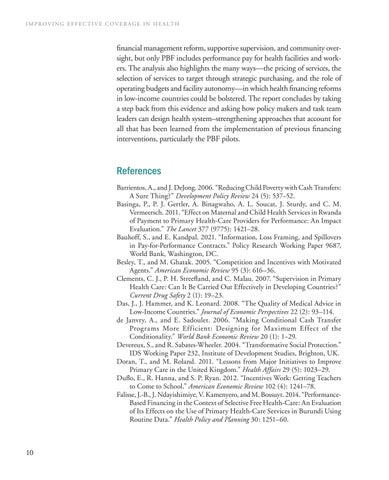IMPROVING EFFECTIVE COVERAGE IN HEALTH
financial management reform, supportive supervision, and community oversight, but only PBF includes performance pay for health facilities and workers. The analysis also highlights the many ways—the pricing of services, the selection of services to target through strategic purchasing, and the role of operating budgets and facility autonomy—in which health financing reforms in low-income countries could be b olstered. The report concludes by taking a step back from this evidence and asking how policy makers and task team leaders can design health system–strengthening approaches that account for all that has been learned from the implementation of previous financing interventions, particularly the PBF pilots.
References Barrientos, A., and J. DeJong. 2006. “Reducing Child Poverty with Cash Transfers: A Sure Thing?” Development Policy Review 24 (5): 537–52. Basinga, P., P. J. Gertler, A. Binagwaho, A. L. Soucat, J. Sturdy, and C. M. Vermeersch. 2011. “Effect on Maternal and Child Health Services in Rwanda of Payment to Primary Health-Care Providers for Performance: An Impact Evaluation.” The Lancet 377 (9775): 1421–28. Bauhoff, S., and E. Kandpal. 2021. “Information, Loss Framing, and Spillovers in Pay-for-Performance Contracts.” Policy Research Working Paper 9687, World Bank, Washington, DC. Besley, T., and M. Ghatak. 2005. “Competition and Incentives with Motivated Agents.” American Economic Review 95 (3): 616–36. Clements, C. J., P. H. Streefland, and C. Malau. 2007. “Supervision in Primary Health Care: Can It Be Carried Out Effectively in Developing Countries?” Current Drug Safety 2 (1): 19–23. Das, J., J. Hammer, and K. Leonard. 2008. “The Quality of Medical Advice in Low-Income Countries.” Journal of Economic Perspectives 22 (2): 93–114. de Janvry, A., and E. Sadoulet. 2006. “Making Conditional Cash Transfer Programs More Eff icient: Designing for Maximum Effect of the Conditionality.” World Bank Economic Review 20 (1): 1–29. Devereux, S., and R. Sabates-Wheeler. 2004. “Transformative Social Protection.” IDS Working Paper 232, Institute of Development Studies, Brighton, UK. Doran, T., and M. Roland. 2011. “Lessons from Major Initiatives to Improve Primary Care in the United Kingdom.” Health Affairs 29 (5): 1023–29. Duflo, E., R. Hanna, and S. P. Ryan. 2012. “Incentives Work: Getting Teachers to Come to School.” American Economic Review 102 (4): 1241–78. Falisse, J.-B., J. Ndayishimiye, V. Kamenyero, and M. Bossuyt. 2014. “PerformanceBased Financing in the Context of Selective Free Health-Care: An Evaluation of Its Effects on the Use of Primary Health-Care Services in Burundi Using Routine Data.” Health Policy and Planning 30: 1251–60.
10

